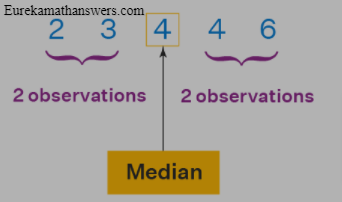In statistics, Data is classified into two types ie., Grouped data and Ungrouped data. Ungrouped data is the information ie., characteristics or numbers that are not segregated into any groups or categories. Median is one of the most important measures in central tendency in statistics. Want to know more about the median of raw data? jump into the further modules and get to learn what is statistics median, the formula of Median, how to calculate median of ungrouped data, and solved examples of Median of discrete data.
Do Refer:
Median of Raw Data – Definition
The Median of Raw Data is the middlemost number in the data set achieved after ordering the data from small to big in two equal parts. Also, it is the number that is halfway into the dataset.
For example, let’s assume the set of raw data: 6, 4, 3, 4, 2 to find the median. Now, arrange the data in ascending order: 2, 3, 4, 4, 6 and find the n observations ie., n=5 here n is odd then media of raw data is middle value i.e. 4. Therefore, 4 is the median of the given dataset.

Median Formula for Ungrouped Data
- The formula of Median = [(n+1)/2]th observation, if n is odd.
- The formula to find median of ungrouped data if n is even is M = \(\frac { 1 }{ 2 } \) { (n/2)th+(n/2+1)th}
Method to Calculate Median of Ungrouped Data
Step by Step explanation of calculating the median of raw data is given here. Simply, follow the below steps without any fail and learn how to find the median of ungrouped data.
- Firstly, arrange the given raw data in ascending or descending order.
- Calculate the number of observations in the given data and then it is denoted by n.
- An important part of solving the median problems is knowing the n is odd or even to find the median of the data.
- If n is odd, the [(n+1)/2]thobservation is the median of raw data.
- If n is even, the mean of (n/2)th observation and [(n/2)+1]th observation is the median ie.,
Median = \(\frac { 1 }{ 2 } \) { (n/2)th+(n/2+1)th}
Solved Examples on Calculating the Median of Discrete Data
Example 1:
Find the median of the raw data: 10, 25, 5, 15, 20.
Solution:
Given raw data is 10, 25, 5, 15, 20
Arrange the data in ascending order ie., 5, 10, 15, 20, 25
The number of observations is 5, which is odd.
Hence, Median = \(\frac { 5+1 }{ 2 } \) = \(\frac { 6 }{ 2 } \) = 3rd observation = 15.
Example 2:
Find the median of the following gasoline price: $1.79, $1.61, $1.96, $2.09, $1.84, $1,75, $2.11
Solution:
Given gasoline prices are $1.79, $1.61, $1.96, $2.09, $1.84, $1,75
Organize the data from least to greatest ie., $1.61, $1.75, $1.79, $1.84, $1.96, $2.09
Number of states are 6, which is even
Median = \(\frac { 1 }{ 2 } \) { (n/2)th+(n/2+1)th}
= \(\frac { 1 }{ 2 } \) { (6/2)th+(6/2+1)th}
= \(\frac { 1 }{ 2 } \) {1.79+1.84}
= \(\frac { 1.79+1.84 }{ 2 } \)
= \(\frac { 3.63 }{ 2 } \)
= 1.815
Hence, the median of gasoline prices is $1.81
Example 3:
Let’s consider the data: 34, 67, 87, 23, 12, 55, 8. What is the median?
Solution:
Given data is 34, 67, 87, 23, 12, 55, 8
Arrange the data from smallest to highest i.e., 8, 12, 23, 34, 55, 67, 87
The number of variants is 7, which is odd then median = middle value
Hence, Median = 34 (middle value in the data).
FAQs on Median
1. What is the median?
In easy words, the middle value of the given data is called the median in statistics.
2. What is the median formula for continuous data?
If the data is in continuous series then we will take the cumulative frequencies, values from the class-interval (N/2)th term. To find the median for continuous data, we use the formula: M= L – Cf-N1/f × i
3. What is the Median of grouped data formula?
For grouped data, the median of frequency distribution is calculated by the formula: Median = l + [(n/2−cf)/f] × h
4. How to find the Median class of ungrouped data?
Follow the steps given below and calculate the median class for raw data:
1. Firstly, arrange the data values in ascending order.
2. If required use the median formula c = (n + 1)/2 where n is the total number of observations.
3. Look for the value at (n + 1)/2. Use the result in step 2. If c holds a fractional half, it means the average of two values is a median.